
table of contents
- Shade plants
- Plants for the light shade
- From
- From G - S
- Plants for open shade
- Plants for partial shade
- From A - E
- From F - H
- From K - M
- From N - S
- Plants for full shade
Plants mostly need sunlight to live. Darker areas in gardens and on balconies therefore often remain unplanted, dreary and bare. It doesn't have to be, because there are numerous flowering plants that set color contrasts in dark, boring areas in shady or partially shaded areas. But be careful, because not all shadows are created equal. Here you will find the differences and numerous ideas for flowering shade plants.
Shade plants
When we speak of shade plants, it does not automatically mean that they can do well in a location that is not exposed to sunlight. The differences are far-reaching and must be taken into account when choosing the plants.
Light shade
This is the lightest form of the shadow. It is a location where sunlight arrives continuously but is occasionally interrupted. This is the case, for example, when the foliage of a neighboring tree swings back and forth between light and plants due to the wind. Light shadow is also referred to when the light hits the plants only in a weakened manner, such as shining through transparent pergolas or mildly through plexiglass.
Open shadow
Open shadow is also called absurd designated. This means a location where daylight shines on the plants for many hours without direct sunlight. Such locations are mainly to be found in inner courtyards surrounded by light walls, whereby the masonry reflects the sunlight and thus ensures sufficient daylight.
Penumbra
We speak of partial shade when the "sun migration" causes about 4 hours of sunlight to fall on the site and the plants are in the shade for the rest of the day. Places where shade is created by, for example, tree tops, building facades or walls are ideal. Often, shade plants are sensitive to the hot midday sun and tolerate the morning sun Sun exposure better than that in the afternoon because it is cooler and penumbra mostly too Burns are prone to. Locations that are oriented to the east are the best. There the sun rises in the morning and has already moved on by noon.
Full shade
There are only a few plants that can exist in full shade because there is a minimum of light available. Especially under dense deciduous and coniferous trees, as well as on walls and facades facing north, there is full shade.
Plants for the light shade
From
Cyclamen
Cyclamen are predominantly called Houseplant held, but they look just as good in the garden bed and on the balcony. In particular, the cyclamen coum that blooms in spring and the cyclamen hederifolium with ivy-like leaves are ideal eye-catchers in the perennial bed.
- Flowering period of early spring cyclamen: between February and March to April.
- "Normal" varieties: between July and April
- Height: between ten and 15 centimeters
- Different flower colors available

Note: Cyclamen are not frost-resistant. For this reason, early varieties are not ideal for the garden bed or the balcony box, that is because, they are protected from the wind and are protected against temperatures below 10 ° C with a plant fleece protected.
Lead root
The leadwort (Plumbago auriculata) is a winter-resistant, flowering giant perennial that takes up a lot of space. It can be used in many ways and delights hobby gardeners with great flowers and easy care. Plumbago auriculata occurs most often, followed by the sky-blue flowering 'Caerulea'. White flowers, on the other hand, are offered by the 'Alba' variety, which is rarely available.
- Flowering period: June to autumn
- Flower color: different shades of blue, less often white or pink-red
- Growth height: depending on the variety up to 2.5 meters
- Suitable as a shrub, hanging plant and ground cover
- Conditionally hardy
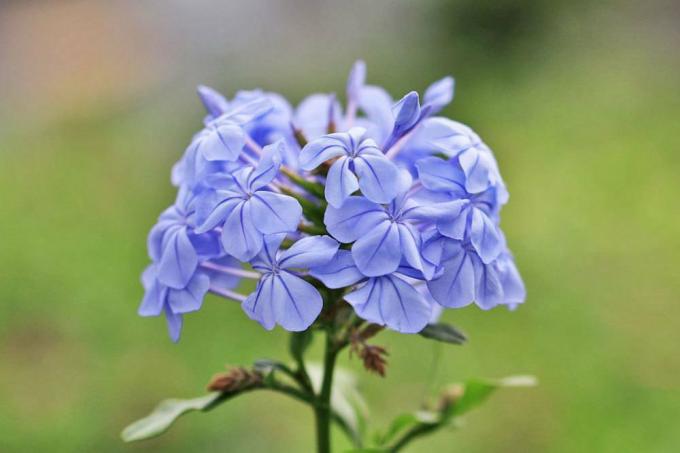
Note: While the lead root actually with appropriate protection against the cold in the garden bed in a place sheltered from the wind can overwinter, the pink-red blooming Plumbago indica is in a warmer location to overwinter respect, think highly of.
From G - S
Bellflower
Bell-shaped flowers make the bellflower (Campanula) a very special appearance. While its green spreads like a carpet in all directions, the splendor of flowers stands out above them. As a rule, these are perennial plants that also tolerate open shade as well as partial shade.
- Perennial with fine, dense foliage
- Height: ten to 15 centimeters
- Flowering period: June to September - sometimes to October
- Flower color: lavender blue
- Ideal for planting in the perennial bed, in rock gardens and tubs or in the living room
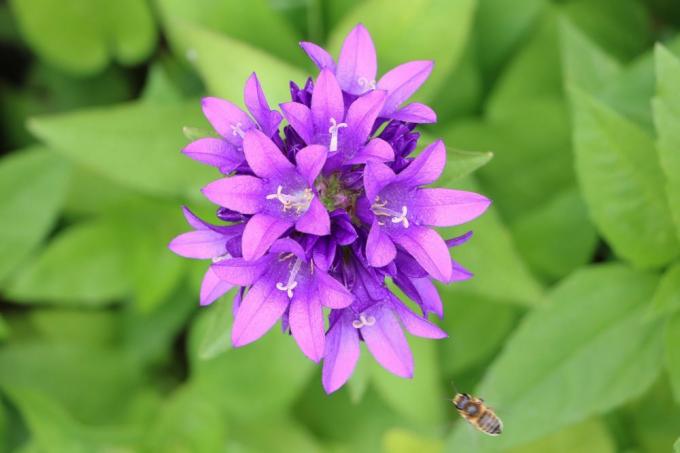
Grove flower
This flowering plant enchants garden beds and balconies for one season. For the living room However, a grove flower (Nemophila) is less suitable because it requires a lot of space in width to be able to spread out in all directions like a carpet. But it is a real eye-catcher in Raised beds, brings color under the branches of the trees and is also easy to care for. It is also important to ensure that it receives at least four hours of sunlight, because it does not bloom in full shade.
- Low, carpet-like, annual water leaf plant
- Growth height: a maximum of 20 centimeters
- Flowering time: depending on the variety between May and September
- Flower color: white, blue, white-blue mix
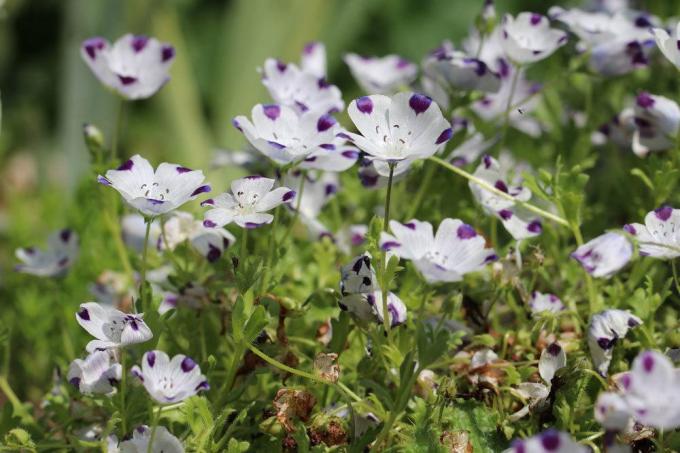
Sun hat
Both coneflower plants (Rudbeckia and Echinacea) get along well in partial shade, but the flowers may not be as lush as in a sunnier location. The yellow specimens in particular are somewhat similar to the sunflower blossom. They enrich every partially shaded place with strong colors.
- Flower color: shades of pink, yellow, lilac, Red orange
- Flowering period: June / July to September / October depending on the variety
- Height: between 40 centimeters and two meters
- Ideal for flower meadows and natural gardens
- Perennial perennials need protection from the cold in winter
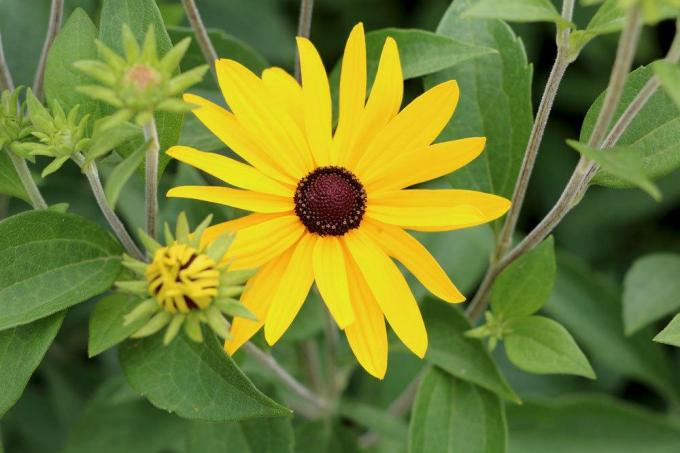
Plants for open shade
rhododendron
Among the shade plants, the rhododendron is one of the most widespread representatives. It is a real flower miracle and changes its flower color with the respective pH value of the soil. It is suitable for the garden bed and for planting in pots on balconies and terraces. He gets along just as well in partial shade.
- Evergreen shrub
- Growth height: mini specimens up to 40 centimeters - otherwise up to four meters (depending on the variety)
- Flowering time: early flowering rhododendron varieties from March / April to May - spring flowering from May to June - summer flowering in July - autumn flowering from August to October
- Flower color: pink-white, pink tones, white, red, bright orange, yellow tones, shades of purple
- Hardy
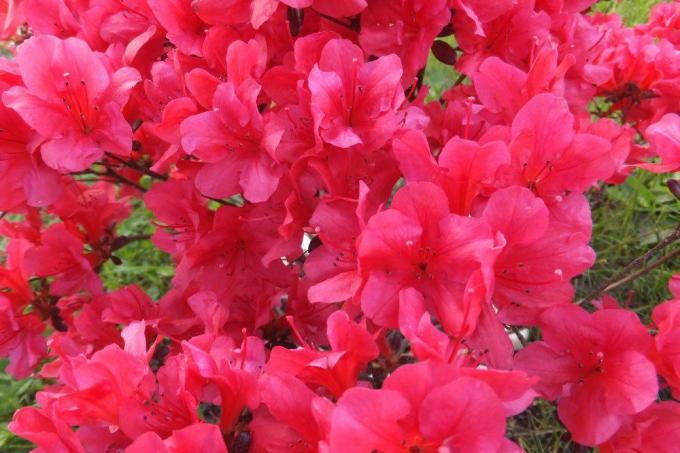
Silver candle
This silver candle (Cimicifuga ramosa) also gets along well with moderate to little light. The perennial forms flower spikes with a pleasantly intense fragrance.
- Clumpy, upright growing and flowering perennial
- Growth height: up to 180 centimeters
- Flower color: pure white
- Flowering period: September to October
- Hardy

Plants for partial shade
From A - E
Anemone / autumn anemone
This perennial (Anemone hupehensis) is one of the autumn bloomers and inspires with its delicate flowers, which grow lush and set color contrasts in partially shaded locations.
- Flowering period: between August and the end of October
- Strong growing
- Growth height: up to 120 centimeters
- Flower color: from white to pink tones to strong red

Arum
The arum is actually a leaf ornament plant. But beautiful flowers form, from which bright red berries develop, so that it should not be missing from the list as a flowering plant for the penumbra.
- Height: up to 60 centimeters
- Flowering time: spring
- Fruits: red berries on upright stems in autumn
- Frostproof
- Use: flowering plant, cut flower

Christmas rose
The Christmas rose (Helleborus niger) is an easy-care plant that enchants the beds with its white flowers even in winter.
- Wintergreen, perennial buttercup plant
- Flowering period: December to March
- Flower color: white, sometimes white-pink
- Height: between ten and 30 centimeters
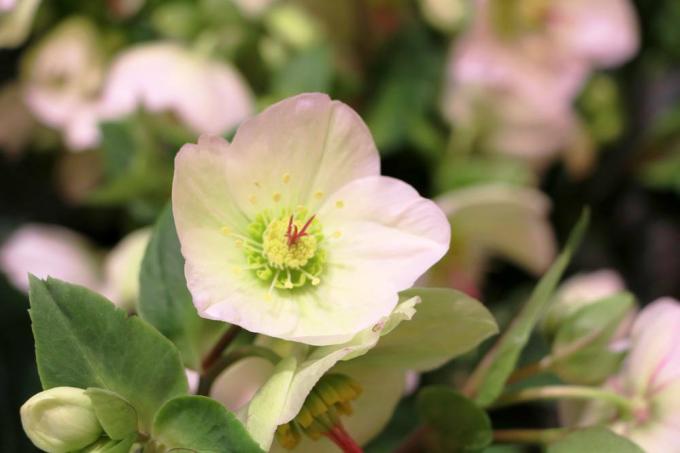
Ivy bush 'Arborescens'
In contrast to conventional ivy (Hedera helix), this genus grows as a shrub and not as a climbing or ground cover plant. It makes hardly any demands on the location in terms of light, which is why it thrives just as well in the sun as it does as a shade plant in partial shade.
- Height: between 80 and 180 centimeters
- Evergreen and winter hardy
- Flower color: yellow
- Flowering period: September to October
- Ideally suited as a hedge
Monkshood
The roots of monkshood (Aconitum napellus) are highly poisonous, while all other parts of the plant are slightly less Toxicity exhibit. It grows splendidly in partial shade and fills its surroundings with strong colors.
- Upright growth
- Height between 50 and 150 centimeters
- Flowering period: June to August
- Flower color: violet tones to intense blue (blue monkshood), yellow and red
- Hardy and easy to care for
- Also ideal as a ground cover

From F - H
thimble
The foxglove (digitalis) is particularly at home on farms, but is now increasingly popular as a garden and balcony plant. Large inflorescences fill the surroundings with magnificent colors, which are just as lush in partial shade as in the sun.
- Imposing biennial perennial with bell flowers
- Height: between 60 and 200 centimeters
- Flower color: depending on the variety, white, red to blue-red, purple or pink
- Flowering period: July to August
- Hardy
- Caution: poisonous seeds
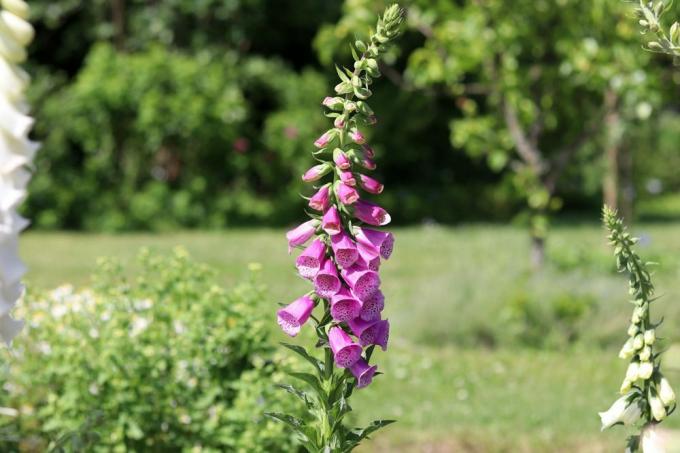
Commemorate
The memorial (Omphalodes verna) brings color to partially shaded places. The predatory leaf plant, also known as light carnation or spring navel, resembles the classic forget-me-not with star-shaped flowers. It is ideal for places that should be eye-catching through color.
- Herbaceous perennial
- Growth height: up to 15 centimeters, rarely up to 25 centimeters
- Flower color: blue and white
- Flowering time: depending on the variety, April to May or May to June
- Hardy
- Spreads out like a carpet
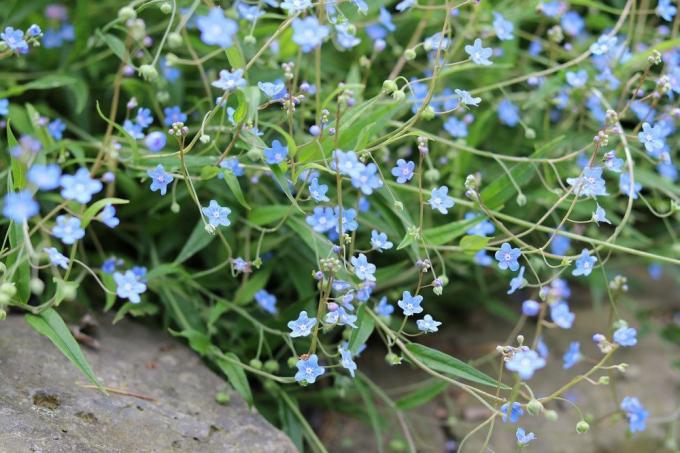
Heart-leaved bergenia
In terms of light conditions, the heart-leaved bergenia (Bergenia cordifolia) is undemanding. She likes the partial shade best, although she doesn't mind a few more hours of sun either.
- Evergreen, robust perennial
- Flowers from April to March
- After pruning the flowers, a second flowering phase is possible in autumn
- Bell-shaped flowers of different colors
- Height: between 15 and 40 centimeters
- Ideal as an ornamental plant for Rock gardens, Discounts, in groups of trees and on the banks of ponds or lakes
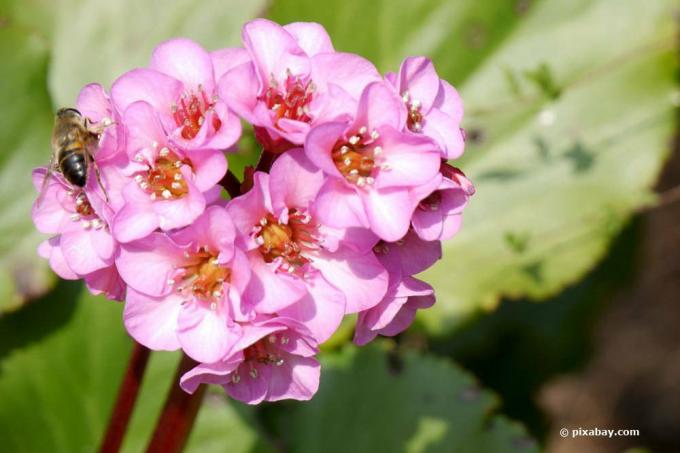
From K - M
Caucasus forget-me-nots
The Caucasus forget-me-not (Brunnera macrophylla 'Variegata') is actually one of the foliage plants because its yellow-white variegated leaves are heart-shaped and outlined in white. Nevertheless, it brings intense color to shady places in spring.
- Ground-covering, bushy growing perennial
- Flowering period: April to May
- Flower color: deep blue
- Growth height: up to 45 centimeters

Toad lily
The shade plants from Japan are among the late bloomers and provide color accents when the garden / balcony has lost its color. Because of the "tiger pattern" of the flowers, it is also called the tiger lily (Tricyrtis). There are around 23 different species, all of which prefer partially shaded to shady locations.
- Height: up to one meter
- Flowering period: September to October
- Flower color: depending on the variety, white, purple to purple, orange and always speckled in a different color
- Conditionally hardy

Larkspur
The lark spur (Corydalis) comes from the poppy family. There are between 300 and 400 different types. Most thrive in partial shade as well as in the sun. But be careful: many own them poisonous plant parts, such as the fingered larkspur.
- Flowers on panicles
- Flowering period: May to September
- Flower color: white, yellow and purple tones
- Annual or perennial species available
- Growth height: dwarf larkspur about ten centimeters - other species up to 20, less often 30 centimeters

Mondviole / Persistent silver leaf
The moon violet (Lunaria rediviva) presents itself as a cruciferous plant, which enchants as a perennial perennial with a fine fragrance. It is particularly at home in dark mountain forests and is highly valued by amateur gardeners as a shade plant.
- Flower color: light to dark violet-colored large cruciferous flowers
- Flowering period: May to July
- Growth height: up to 120 centimeters
- Forms silvery pods in autumn
- Has an intense scent at night
From N - S
Clove root
Once provided in Chile for lush carpets of flowers, the avens (Geum chiloense) has long since moved into central European gardens. There it thrives splendidly in partially shaded locations and inspires with a display of flowers in wonderful colors that last for weeks.
- Robust, perennial plants
- Flowering time: depending on the variety between May and July
- Flower color: golden yellow, yellow, orange-red, lilac
- Height: between 20 and 80 centimeters
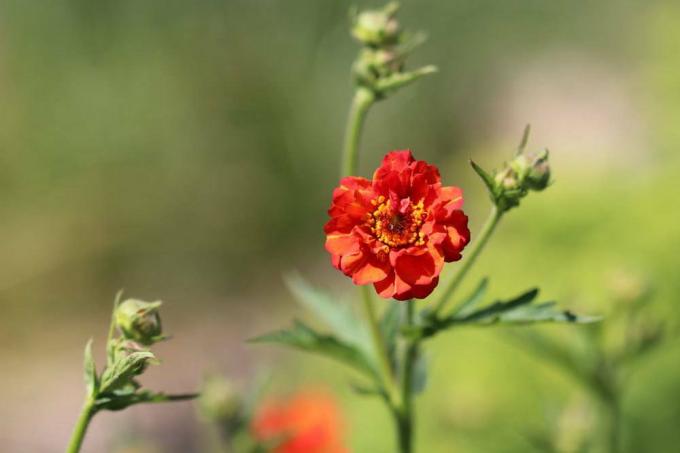
Splendid spar
The splendor spar (Astilbe) is a colorful perennial that blooms from early summer to autumn. It is characterized above all by its resilience and its interesting appearance. The hardy saxifrage plant is not only decorative in the garden or on the balcony, but also brings nature into living rooms as a cut flower.
- Flowering period: June to September
- Flower colors: red, white, shades of purple
- Height: between 15 and 120 centimeters
- Frostproof
- Can be ideally combined with other shade plants

Purple bells
Purple bells (Heuchera micrantha) are ideal for creating unique contrasts between the reddish-brown foliage and the flowers in partially shaded locations. The heart-shaped and slightly wavy leaves also have a decorative effect.
- Evergreen perennial
- Growth height: smallest varieties around 15 centimeters - high varieties up to 70 centimeters
- Small flower bells on slender panicles
- Flowering period: July / August
- Flower color: white as well as red and pink tones
- Winter hardy to -15 ° C
- Attracts bees and butterflies
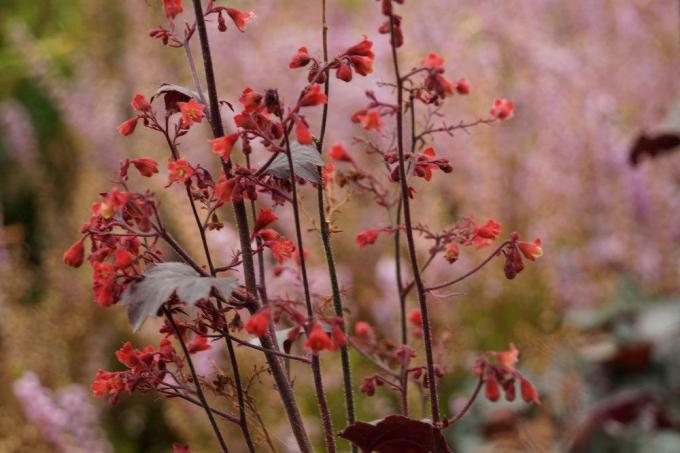
sage
Sage (Salvia) is mainly used as a culinary herb, but also adorns places in partial shade depending on the variety. The steppe sage (Salvia nemerosa) in particular fits perfectly into a perennial bed, although it also feels good in pots and window boxes.
- Flower color: blue-violet
- Flowering period: May to July
- Height: between 40 and 60 centimeters
- Prefers dry and barren locations
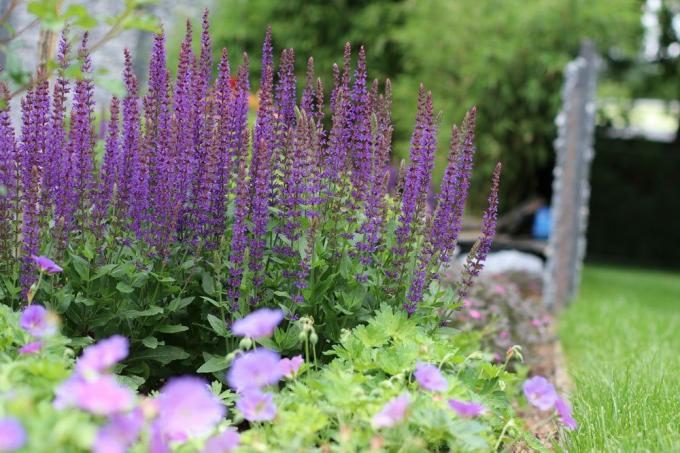
Plants for full shade
Ruprecht's herb
The Ruprechtskraut (Geranium robertianum) or smelly cranesbill, reacts quickly to too much light with a sunburnwhich in the worst case can even lead to the death of the shade plants. The herb grows wild, especially in the shady forest. In a shady spot in the home garden or on the balcony, it will delight you with months of bloom.
- Height: up to 50 centimeters
- Flowering period: May to October
- Flower color: pink
- Musty smell that drives away mosquitos
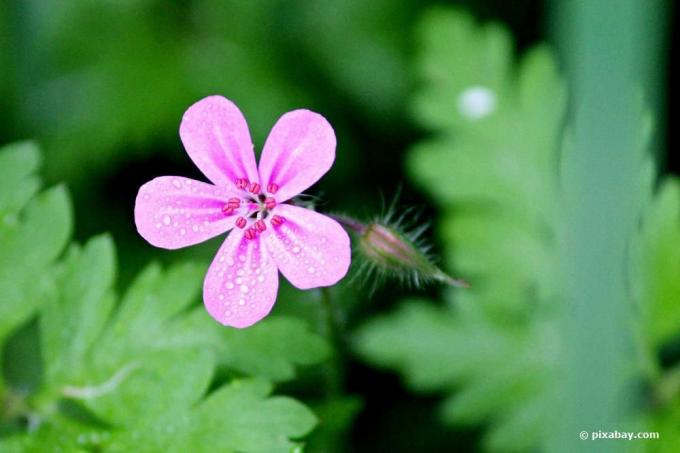
Forest goat's beard / goat's beard
The goat's beard (Aruncus dioicus) is a real classic among the shade plants. Magnificent panicles of flowers combined with long leaflets characterize it. It likes it wet, which is why it can also be found wild on stream and lake banks as well as on the edges of forests. In German gardens and on balconies, the easy-care wild shrub is a decorative eye-catcher in partially shaded / fully shaded locations.
- tall perennial
- Height: between 80 and 200 centimeters
- Flowering period: May to June
- Flower color: white to cream-white
- Perennial and frost-resistant

Forest lily
The forest lily (Trillium) is one of the most popular shade plants, which makes you look forward to summer. A location in the shade under deciduous plants is ideal when the leaves rot there and meet the relatively high nutrient requirements of the forest lily.
- Flower color: white
- Flowering period: April to May
- Height: up to 40 centimeters
- Trefoil flower
- Hardy
- Ideal for underplanting trees and shrubs
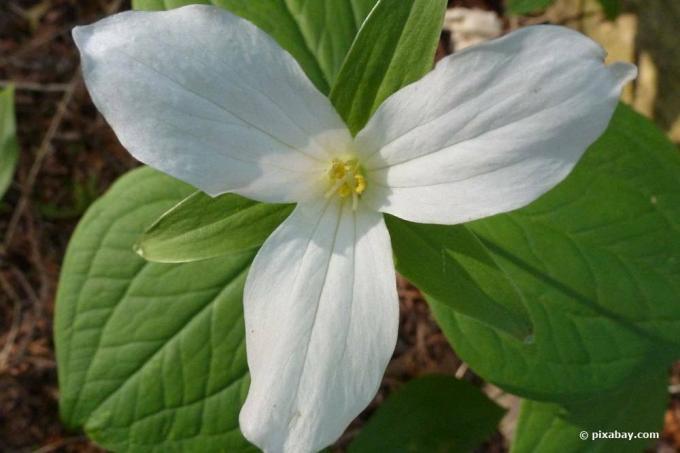
tip: The water requirements of shade plants should not be underestimated, especially during the summer months. Because warmth and wind also reach the penumbra area. Regular control of the moisture content is therefore essential.

